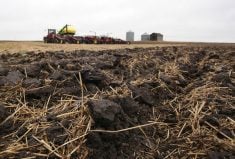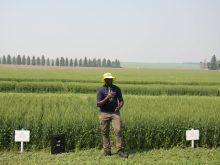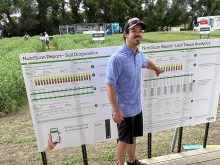INDIANAPOLIS, Ind. — Making more crop with less nitrogen is the secret to the supply issues that will plague the product as the world pushes for more food.
Nitrogen is the biggest of the big three crop nutrients applied by farmers — nitrogen, potassium and phosphorus — representing 100 million of the 169 million tonnes of product applied on the world’s farms.
“Farmers (in the commercially developed world) are very motivated to be efficient in their use of fertilizers, not just because of environmental pressures, mostly monetary pressures, to get as much fertilizer into the plants as possible and control losses, improving their profitability,” Madanl Gupta of the University of Queensland told the International Society of Precision Agriculture’s recent biennial conference in Indianapolis.
Read Also

House ag committee to undertake several studies
The House of Commons standing agriculture committee has set its agenda for the coming months. Members began the fall sitting with a two-hour update on international trade
He said there would be less demand on the current supply if China and India could adopt more efficient farming strategies, similar to those of the European Union and North America.
China is the largest user of nitrogen, taking up 31 percent of the global supply. India is number two with 14.6 percent. The United States uses 11.5 percent, nearly tied with the EU at 11.6.
Gupta said half of the world’s annual production goes to wheat, corn and rice, but only 30 to 50 percent is used by plants.
“More than half of the N not assimilated by plants becomes a potential source of environmental pollution, such as ground water contamination, eutrophication, acid rain, ammonia redeposition, global warming and stratospheric ozone depletions,” he said.
“We can’t expect to capture it all, but precision agricultural techniques help to minimize the losses.… Just a 10 percent improvement in these three crops would put $5 billion each year back into farmers’ hands and reduce the need to produce it in the first place.”
Raj Kholsa of the University of Colorado’s soil and crop science department said many producers typically apply one rate of nitrogen across the whole field, without regard for special variation in the needs of the plants they are growing.
He said that practice, combined with a reliance on a single application of fertilizer at or before planting, results in significant nitrogen losses.
Producers could lower their costs and increase nitrogen use efficiency by using precision agricultural application strategies such as variable rates and just-in-time delivery, he added.
“The population of the world is now seven billion,” he said.
“By 2025 it will be eight. That’s not too far away. A billion more people will put a significant demand on our food production and distribution systems.”
Based on nitrogen use efficiency (NUE) calculations, China is the least efficient of the major grain producers. In 2010, the country managed an NUE of 30 percent with its wheat and 33 percent in corn.
India was 38 percent efficient in wheat and 53 percent in corn. The U.S. has NUEs of 66 and 56, while the EU is 70 and 45.
“China uses a third of all of the global nitrogen. If they could be closer to U.S. and EU NUEs, it would make a huge difference and reduce all of the (negative) effects of inefficiency,” Gupta said.
“And that isn’t saying that the developed countries are as efficient as they could be, but the biggest gains for now are in China and India.”
Economist Terry Griffin of the University of Arkansas said the need to increase supply to meet world food and feed demands can be partially met through more efficient use.
“But more efficient doesn’t always mean less,” he said.
“It might mean maximizing its effectiveness. Farmer adoption is often, OK, mostly, driven by economics. High prices for fertilizer and for crops, here and elsewhere in the world help make precision approaches happen.”
Harold Reetz, a pioneer of precision agriculture in North America, agreed.
“I know you’re hearing it a lot, but the right (fertilizer) product at the right rate in the right place at the right time is what we need for this issue of efficiency,” said Reetz of Montechelo, Missouri.

















